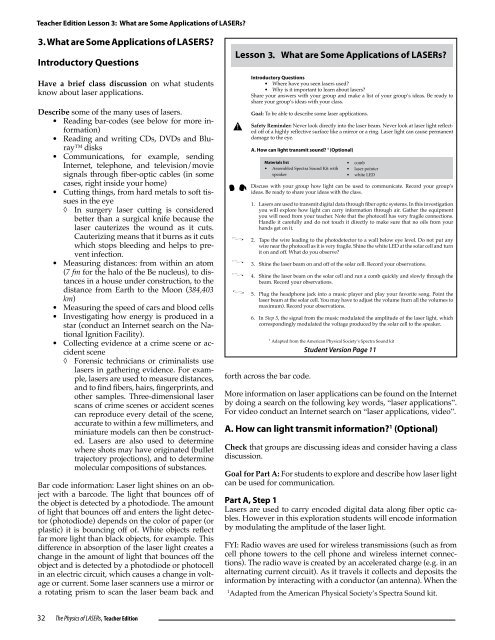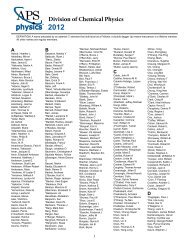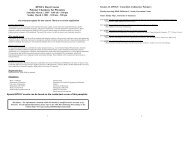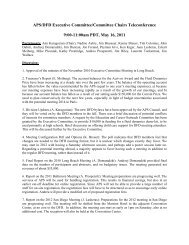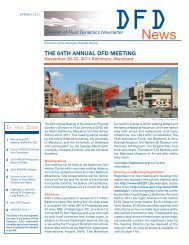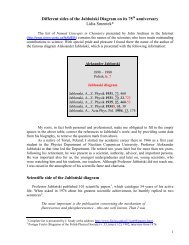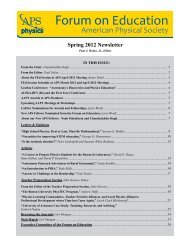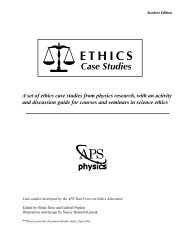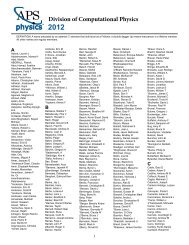The Physics of LASERs - American Physical Society
The Physics of LASERs - American Physical Society
The Physics of LASERs - American Physical Society
You also want an ePaper? Increase the reach of your titles
YUMPU automatically turns print PDFs into web optimized ePapers that Google loves.
Teacher Edition Lesson 3: What are Some Applications <strong>of</strong> <strong>LASERs</strong>?<br />
3. What are Some Applications <strong>of</strong> LASERS?<br />
Introductory Questions<br />
Have a brief class discussion on what students<br />
know about laser applications.<br />
Describe some <strong>of</strong> the many uses <strong>of</strong> lasers.<br />
• Reading bar-codes (see below for more information)<br />
• Reading and writing CDs, DVDs and Bluray<br />
disks<br />
• Communications, for example, sending<br />
Internet, telephone, and television/movie<br />
signals through fiber-optic cables (in some<br />
cases, right inside your home) <br />
• Cutting things, from hard metals to s<strong>of</strong>t tissues<br />
in the eye<br />
◊ In surgery laser cutting is considered<br />
better than a surgical knife because the<br />
laser cauterizes the wound as it cuts.<br />
Cauterizing means that it burns as it cuts<br />
which stops bleeding and helps to prevent<br />
infection.<br />
• Measuring distances: from within an atom<br />
(7 fm for the halo <strong>of</strong> the Be nucleus), to distances<br />
in a house under construction, to the<br />
distance from Earth to the Moon (384,403<br />
km)<br />
• Measuring the speed <strong>of</strong> cars and blood cells<br />
• Investigating how energy is produced in a<br />
star (conduct an Internet search on the National<br />
Ignition Facility).<br />
• Collecting evidence at a crime scene or accident<br />
scene<br />
◊ Forensic technicians or criminalists use<br />
lasers in gathering evidence. For example,<br />
lasers are used to measure distances,<br />
and to find fibers, hairs, fingerprints, and<br />
other samples. Three-dimensional laser<br />
scans <strong>of</strong> crime scenes or accident scenes<br />
can reproduce every detail <strong>of</strong> the scene,<br />
accurate to within a few millimeters, and<br />
miniature models can then be constructed.<br />
Lasers are also used to determine<br />
where shots may have originated (bullet<br />
trajectory projections), and to determine<br />
molecular compositions <strong>of</strong> substances.<br />
Bar code information: Laser light shines on an object<br />
with a barcode. <strong>The</strong> light that bounces <strong>of</strong>f <strong>of</strong><br />
the object is detected by a photodiode. <strong>The</strong> amount<br />
<strong>of</strong> light that bounces <strong>of</strong>f and enters the light detector<br />
(photodiode) depends on the color <strong>of</strong> paper (or<br />
plastic) it is bouncing <strong>of</strong>f <strong>of</strong>. White objects reflect<br />
far more light than black objects, for example. This<br />
difference in absorption <strong>of</strong> the laser light creates a<br />
change in the amount <strong>of</strong> light that bounces <strong>of</strong>f the<br />
object and is detected by a photodiode or photocell<br />
in an electric circuit, which causes a change in voltage<br />
or current. Some laser scanners use a mirror or<br />
a rotating prism to scan the laser beam back and<br />
32<br />
<strong>The</strong> <strong>Physics</strong> <strong>of</strong> <strong>LASERs</strong>, Teacher Edition<br />
Lesson 3.<br />
!<br />
forth across the bar code.<br />
Student Edition Lesson 3: What are Some Applications <strong>of</strong> <strong>LASERs</strong>?<br />
What are Some Applications <strong>of</strong> <strong>LASERs</strong>?<br />
Introductory Questions<br />
• Where have you seen lasers used?<br />
• Why is it important to learn about lasers?<br />
Share your answers with your group and make a list <strong>of</strong> your group’s ideas. Be ready to<br />
share your group’s ideas with your class.<br />
Goal: To be able to describe some laser applications.<br />
Safety Reminder: Never look directly into the laser beam. Never look at laser light reflected<br />
<strong>of</strong>f <strong>of</strong> a highly reflective surface like a mirror or a ring. Laser light can cause permanent<br />
damage to the eye.<br />
A. How can light transmit sound? 1 (Optional)<br />
Materials list<br />
• Assembled Spectra Sound Kit with<br />
speaker<br />
• comb<br />
• laser pointer<br />
• white LED<br />
Discuss with your group how light can be used to communicate. Record your group’s<br />
ideas. Be ready to share your ideas with the class.<br />
1. Lasers are used to transmit digital data through fiber optic systems. In this investigation<br />
you will explore how light can carry information through air. Gather the equipment<br />
you will need from your teacher. Note that the photocell has very fragile connections.<br />
Handle it carefully and do not touch it directly to make sure that no oils from your<br />
hands get on it.<br />
2. Tape the wire leading to the photodetector to a wall below eye level. Do not put any<br />
wire near the photocell as it is very fragile. Shine the white LED at the solar cell and turn<br />
it on and <strong>of</strong>f. What do you observe?<br />
3. Shine the laser beam on and <strong>of</strong>f <strong>of</strong> the solar cell. Record your observations.<br />
4. Shine the laser beam on the solar cell and run a comb quickly and slowly through the<br />
beam. Record your observations.<br />
5. Plug the headphone jack into a music player and play your favorite song. Point the<br />
laser beam at the solar cell. You may have to adjust the volume (turn all the volumes to<br />
maximum). Record your observations.<br />
6. In Step 5, the signal from the music modulated the amplitude <strong>of</strong> the laser light, which<br />
correspondingly modulated the voltage produced by the solar cell to the speaker.<br />
1 Adapted from the <strong>American</strong> <strong>Physical</strong> <strong>Society</strong>’s Spectra Sound kit<br />
Student Version Page 11<br />
<strong>The</strong> <strong>Physics</strong> <strong>of</strong> <strong>LASERs</strong><br />
More information on laser applications can be found on the Internet<br />
by doing a search on the following key words, “laser applications”.<br />
For video conduct an Internet search on “laser applications, video”.<br />
A. How can light transmit information? 1 (Optional)<br />
Check that groups are discussing ideas and consider having a class<br />
discussion.<br />
Goal for Part A: For students to explore and describe how laser light<br />
can be used for communication.<br />
Part A, Step 1<br />
Lasers are used to carry encoded digital data along fiber optic cables.<br />
However in this exploration students will encode information<br />
by modulating the amplitude <strong>of</strong> the laser light.<br />
FYI: Radio waves are used for wireless transmissions (such as from<br />
cell phone towers to the cell phone and wireless internet connections).<br />
<strong>The</strong> radio wave is created by an accelerated charge (e.g. in an<br />
alternating current circuit). As it travels it collects and deposits the<br />
information by interacting with a conductor (an antenna). When the<br />
1Adapted from the <strong>American</strong> <strong>Physical</strong> <strong>Society</strong>’s Spectra Sound kit.<br />
11


